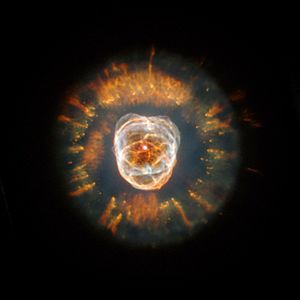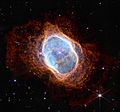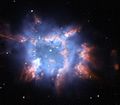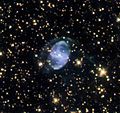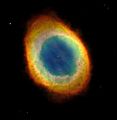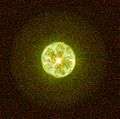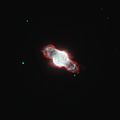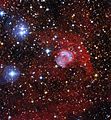Planetary nebula facts for kids
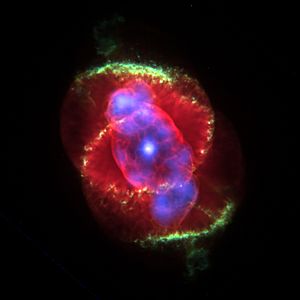
A planetary nebula is a beautiful cloud of gas and plasma in space. It forms when certain types of stars reach the end of their lives. They got their name because they look a bit like planets when seen through small telescopes. But don't be fooled – they are definitely not planets! These amazing objects don't last very long, only tens of thousands of years, which is a blink of an eye compared to a star's billions of years.
When a normal-sized star, like our Sun, starts to die, it enters a phase called a red giant. During this time, the star throws off its outer layers into space. The hot center of the star then shines brightly. The powerful ultraviolet light from this center makes the gas and plasma glow. This is how a planetary nebula gets its colorful and unique look.
Planetary nebulae are very special because they help create new stars. When a star dies, it sends important elements, like metals, out into the universe. These elements were made inside the star's core through a process called nucleosynthesis. These elements then become building blocks for new stars and planets.
The pictures of these nebulae show that they have many strange and wonderful shapes. Scientists are still trying to figure out why they aren't all round like a ball. They have some ideas! They think that binary stars (two stars orbiting each other), strong stellar winds, and powerful magnetic fields might be some reasons for their special shapes.
Contents
Discovering Planetary Nebulae
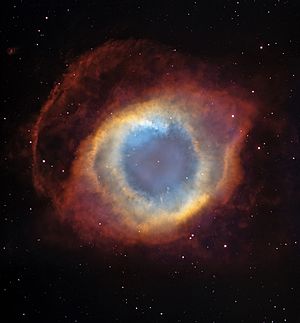
Planetary nebulae are not very bright. You can't see any of them without a telescope. The very first one ever found was the Dumbbell Nebula. When early astronomers saw them, they thought they looked like fuzzy planets. That's why they called them 'planetary nebulae,' and we still use that name today, even though we know they are not planets.
Astronomers didn't truly understand what these objects were until the 1800s. A scientist named William Huggins used a special tool called a prism to study light from space. He looked at galaxies and saw that their light was similar to stars.
But when he looked at the Cat's Eye Nebula, it was different. He saw a bright line of light that no one had ever seen before. This made scientists think it might be a new element! They even gave it a name: nebulium.
Later, physicists discovered that gases with very low density (meaning they are very spread out) can glow in unusual ways. It turned out that the "nebulium" was actually just oxygen glowing under special conditions.
The stars at the center of planetary nebulae are extremely hot. But they are not very bright. This means they must be very small. Stars only get this small when they are dying. So, planetary nebulae are one of the last steps in a star's life. Scientists also saw that all planetary nebulae were growing bigger, or expanding. This proved that they were formed by a star's outer layers being pushed into space.
How Planetary Nebulae Form
Stars that are much heavier than our Sun (more than 8 times its mass) end their lives in a huge explosion called a supernova. But stars that are about the same size as our Sun will become planetary nebulae.
After billions of years, a star will start to run out of hydrogen fuel. This makes the star's core shrink and get much hotter. Our Sun's core is about 15 million degrees Celsius. When it runs out of hydrogen, its core will shrink and heat up to about 100 million degrees Celsius.
The star's outer layers grow very large because of the hot core. The star becomes a red giant. The core gets even smaller and hotter. When it reaches 100 million degrees, another fuel, helium, starts to burn and turn into carbon and oxygen. When this happens, the core stops shrinking.
Because helium burning is not very steady, the core starts to grow and shrink quickly. This pushes the gas and plasma in the star's outer layers outwards. These gases form a cloud around the star's core. As more gas moves away, deeper, hotter layers are sent out. When this gas heats up to around 30,000 degrees Celsius, it starts to glow brightly. At this point, the cloud has become a beautiful planetary nebula.
Where to Find Them
We know of about 3,000 planetary nebulae in our galaxy, the Milky Way. This is a small number compared to the 200 billion stars in our galaxy! Their short lifetime is why there aren't many of them. They are mostly found in the flat part, or plane, of the Milky Way. You'll find more of them closer to the center of the Milky Way.
The Many Shapes of Nebulae
Only about twenty percent of planetary nebulae are spheres (like a perfect ball, such as Abell 39). The rest have very strange and interesting shapes! Scientists don't fully understand why they have so many different forms. Here are some ideas:
- Binary Stars: If a star has a second star orbiting it (a binary star system), their gravity might pull the gas into unusual shapes.
- Planets: Planets orbiting near the dying star might also change how the nebula forms.
- Magnetic Fields: Strong magnetic fields around the star could also shape the glowing gas.
Studying Planetary Nebulae
A big challenge when studying planetary nebulae is figuring out how far away they are. If they are close, astronomers can use a method called expansion parallax. But this takes a very long time. For nebulae that are far away, scientists don't have a good, quick way to measure their distance yet.
Related pages
Images for kids
-
Two cameras aboard Webb Telescope captured the latest image of this planetary nebula, cataloged as NGC 3132, and known informally as the Southern Ring Nebula. It is approximately 2,500 light-years away.
-
ESO 455-10 is a planetary nebula located in the constellation of Scorpius (The Scorpion).
See also
 In Spanish: Nebulosa planetaria para niños
In Spanish: Nebulosa planetaria para niños


